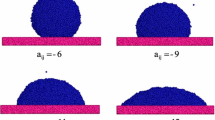Abstract
High Weber number drops are found to undergo a Cassie-to-Wenzel transition on hydrophobic textured surfaces. Previous studies with many-body dissipative particle dynamics (MDPD) method were based on an absolute Cassie state, with no splash. Hence, an MDPD method was developed in this paper, which could simulate drop splashes in a hybrid state. Millimeter-sized drops on hydrophobic substrates were simulated with different solid fraction, and results were compared to experimental results using high-speed photography. The numerical spread diameter, contact time, and splash amount are matched with experiments. Results showed that hydrophobic substrates with lower solid fraction possess better water repellency as compared to those with similar apparent contact angle. However, the influence of the microstructure on superhydrophobic surfaces is much less than that on hydrophobic ones, and surfaces with lower solid fraction did not have better water repellency capabilities. It is believed that the MDPD method proposed in this study can effectively predict relationship between surface topography and water repellency of a material.









Similar content being viewed by others
References
Arienti M, Pan W, Li X, Karniadakis G (2011) Many-body dissipative particle dynamics simulation of liquid/vapor and liquid/solid Interactions. J Chem Phys 134(20):204114
Bartolo D, Josserand C, Bonn, D (2005) Retraction dynamics of aquous drops upon impact on nonwetting surfaces. https://arxiv.org/abs/physics/0509133
Brunet P, Lapierre F, Thomy V, Coffinier Y, Boukherroub R (2008) Extreme resistance of superhydrophobic surfaces to impalement: reversible electrowetting related to the impacting/bouncing drop test. Langmuir 24(19):11203–11208
Cassie ABD, Baxter S (1944) Wettability of porous surfaces. Trans Faraday Soc 40:546–551
Checco A, Ocko BM, Rahman A, Black CT, Tasinkevych M, Giacomello A, Dietrich S (2014) Collapse and reversibility of the superhydrophobic state on nanotextured surfaces. Phys Rev Lett 112(21):216101
Cho EC, Kong H, Oh TB, Cho K (2012) Protein adhesion regulated by the nanoscale surface conformation. Soft Matter 8(47):11801–11808
Deng X, Mammen L, Butt HJ, Vollmer D (2012) Candle soot as a template for a transparent robust superamphiphobic coating. Science 335(6064):67–70
Espanol P, Warren P (1995) Statistical mechanics of dissipative particle dynamics. Europhys Lett 30(4):191
Ghoufi A, Malfreyt P (2011) Mesoscale modeling of the water liquid-vapor interface: a surface tension calculation. Phys Rev E 83(5):051601
Groot RD, Warren PB (1997) Dissipative particle dynamics: Bridging the gap between atomistic and mesoscopic simulation. J Chem Phys 107(11):4423–4435
Lagubeau G, Fontelos MA, Josserand C, Maurel A, Pagneux V, Petitjeans P (2012) Spreading dynamics of drop impacts. J Fluid Mech 713:50–60
Liu MB, Liu GR, Zhou LW, Chang JZ (2015) Dissipative particle dynamics (DPD): an overview and recent developments. Arch Comput Methods Eng 22(4):529–556
Mertaniemi H, Jokinen V, Sainiemi L, Franssila S, Marmur A, Ikkala O, Ras RH (2011) Superhydrophobic tracks for low-friction, guided transport of water droplets. Adv Mater 23(26):2911–2914
Pan D, Phan-Thien N, Khoo, BC (2014) Dissipative particle dynamics simulation of droplet suspension in shear flow at low capillary number. J Nonnewton Fluid Mech 212:63–72
Pernites RB, Santos CM, Maldonado M, Ponnapati RR, Rodrigues DF, Advincula, RC (2011) Tunable protein and bacterial cell adsorption on colloidally templated superhydrophobic polythiophene films. Chem Mater 24(5):870–880
Shen Y, Tao J, Tao H, Chen S, Pan L, Wang T (2015) Approaching the theoretical contact time of a bouncing droplet on the rational macrostructured superhydrophobic surfaces. Appl Phys Lett 107(11):111604
Tsai P, Pacheco S, Pirat C, Lefferts L, Lohse D (2009) Drop Impact upon micro- and nanostructured superhydrophobic surfaces. Langmuir 25(20):12293–12298
Ukiwe C, Kwok DY (2005) On the maximum spreading diameter of impacting droplets on well-prepared solid surfaces. Langmuir 21(2):666–673
Wang Y, Chen S (2015a) Droplets impact on textured surfaces: mesoscopic simulation of spreading dynamics. Appl Surf Sci 327:159–167
Wang Y, Chen S (2015b) Numerical study on droplet sliding across micropillars. Langmuir 31(16):4673–4677
Warren PB (2003) Vapor-liquid coexistence in many-body dissipative particle dynamics. Phys Rev E 68(6):066702
Wang W, Liu Z, Jin Y, Cheng Y (2011) LBM simulation of droplet formation in micro-channels. Chem Eng J 173(3):828–836
Wenzel RN (1936) Resistance of solid surfaces to wetting by water. Ind Eng Chem 28(8):988–994
Wörner M (2012) Numerical modeling of multiphase flows in microfluidics and micro process engineering: a review of methods and applications. Microfluid Nanofluid 12(6):841–886
Yamada T, Yuan J, Sunden BA (2015) Application of many-body dissipative particle dynamics to determine liquid characteristics. Int J Numer Meth Heat Fluid Flow 25(7):1619–1637
Yarin AL (2006) Drop impact dynamics: splashing, spreading, receding, bouncing. Annu Rev Fluid Mech 38:159–192
Zhang R, Hao P, Zhang X, He F (2016) Dynamics of high Weber number drops impacting on hydrophobic surfaces with closed micro-cells. Soft Matter 12(26):5808-5817
Acknowledgements
The study was supported by the State Key Project of Research and Development (Grant No. 2016YFC1100300) and the National Key Technology R&D Program (2014BAI11B06).
Author information
Authors and Affiliations
Corresponding author
Electronic supplementary material
Below is the link to the electronic supplementary material.
Rights and permissions
About this article
Cite this article
Wang, L., Zhang, R., Zhang, X. et al. Numerical simulation of droplet impact on textured surfaces in a hybrid state. Microfluid Nanofluid 21, 61 (2017). https://doi.org/10.1007/s10404-017-1900-0
Received:
Accepted:
Published:
DOI: https://doi.org/10.1007/s10404-017-1900-0




